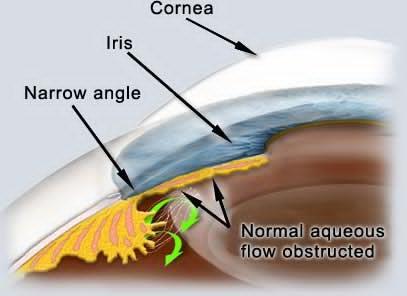
Narrow angle glaucoma (also called acute angle-closure glaucoma or closed-angle glaucoma) is a serious type of glaucoma that occurs suddenly when fluid builds up behind the iris. Although glaucoma is often referred to as the “silent thief of sight” because most people with the disease do not experience symptoms, narrow angle glaucoma can produce severe symptoms.
An acute episode of narrow angle glaucoma is considered a medical eye emergency. If the pressure is not reduced quickly, you may have permanent vision loss. It is important to note that some people with narrow angle glaucoma may not experience symptoms or may experience them intermittently, depending on what is causing the disease.
Narrow Angle Glaucoma Symptoms
Because the eye pressure rises very high in a short period of time, most people will experience the following symptoms:
- Blurred vision
- Red eyes
- Headache
- Eye pain
- Halos around lights
- Mid-dilated pupil
- Nausea
If you are experiencing any of these symptoms, see your optometrist or ophthalmologist immediately, or go to your local emergency room.
Causes of Narrow Angle Glaucoma
The front part of the eye houses the anterior chamber. Some people have a shallow anterior chamber, narrowing the angle of the eye. In such eyes, the iris can bunch up as the pupil dilates and close off the angle. The iris can sometimes close the angle by dilating in a dark room, such as a movie theater.
In some inflammatory eye diseases, the anterior chamber becomes very sticky, causing the back of the iris to stick to the lens of the eye. This causes fluid to back up and push the iris forward, closing off the angle, called pupillary block. Tumors and severe diabetic eye disease can also cause narrow angle glaucoma.
Risk Factors for Narrow Angle Glaucoma
The following risk factors are associated with narrow angle glaucoma:
- Farsightedness: Farsighted individuals are more likely to have a shallow anterior chamber.
- Age: Aging causes changes in the anatomy of the eye, putting you at risk for developing the disease.
- Race: Asians and Eskimos have a higher risk of developing narrow angle glaucoma because they have a shallow anterior chamber and anatomically narrow angles.
- Gender: Women are more likely to have narrow angle glaucoma.
- Cataracts: Cataracts can grow and make the lens of the eye thicker, often pushing the iris forward and causing pupillary block.
Narrow Angle Glaucoma Treatment
To combat the rapid effects of this disease, treatment must begin immediately. Once officially diagnosed, topical glaucoma eye drops are instilled in an attempt to lower the pressure as quickly as possible. Doctors may also prescribe oral medication to reduce pressure and fluid systemically.
Doctors will then perform a laser procedure known as a peripheral iridotomy (PI) to allow the fluid to escape through the iris. An iridotomy is a very small hole in the iris that allows the fluid to pass through.
What You Should Know About Narrow Angle Glaucoma
It is possible to identify people who may be at risk for developing narrow angle glaucoma. Physicians can perform a peripheral iridotomy (PI) as described above even if you are not experiencing symptoms. In this manner, if the angle does close, the iridotomy will allow the fluid a chance to escape so pressure does not rise to dangerous levels. People who have an iridotomy should be examined on an annual basis to ensure that the iridotomy is still open and has not grown closed.

